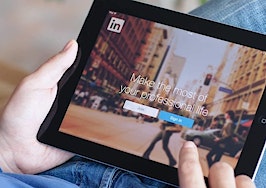- Stop spending money on ineffective marketing methods.
- A small audience is still an audience. Don't get discouraged by 20, 30 or 40 reads.
- If you're not committed to the long game, don't play when it comes to social media.
Agents, it’s time to stop marketing like it’s 2005.
Because it’s not.
Yet real estate agents and brokerages are still latching onto traditional ineffective marketing like it is.
Let me explain.
According to mailermailer.com, in 2005 the average email open rate in real estate was 28 percent. In 2014, that number was 13 percent. That’s a 50-percent decrease in a little less than 10 years. But why?
People are inundated with daily emails including work-related messages, promotions and outright spam. As the amount of email consumers receive increases, the window to grab their attention gets smaller.

Snapshot of my promotions inbox

What’s even more insane is that real estate agents spent $312 million nationwide on direct mail last year. With 44 percent of direct mail going unopened according to hubspot.com, that’s flushing roughly $137 million down the toilet.
We’ve worked with clients who have gotten access to big mail lists and asked for our company’s advice on sending out mailers — trying to bank on spray-and-pray marketing methods. Our advice is simple: don’t do it.
Understanding millennial buyers
According to U.S. News and World Report, millennials will be the biggest homebuying generation of all time, so it’s time to start paying attention to the marketing methods that resonate with them.
First, millennials don’t want to talk on the phone.
So stop calling them. I often hear from agents that say, “I’m a people person. I want to make real connections with people so I prefer to call them.”
Newsflash: millennials don’t want to talk on the phone with you. Hell, they barely speak with their friends and family on the phone.
According to the Wall Street Journal, calling someone without notice makes it seem like you’re prioritizing your time over theirs. Keep this is mind next time you pick up the phone.
Secondly, millennials don’t care about your listings on social media.

The above picture is from an agent who’s sharing his listings on LinkedIn Pulse, so everyone gets a notification whenever he posts. This means that with a single maneuver, he’s succeeded in annoying all of his LinkedIn connections at once.
Who in their right mind would want a notification to go off on their phone that you’ve posted a listing on LinkedIn?
Millennials will use realtor.com, Zillow, Xome, Trulia, etc., to find a property when they’re ready to move. If they want help, they are going to research and find the best agent by asking friends, checking online reviews and social media activity.
Spamming your listings all over social media is like driving with your feet. Sure it might work sometimes, but generally, it’s a horrible idea.
Third, millennials want to get value before they pick an agent. If something doesn’t give value to people, you shouldn’t do it, period.

The above agent, Jessica, is a great example of an agent giving value. She recorded a quick video outlining five tips for first-time sellers. She’s not asking viewers for anything. She’s giving the viewer valuable information, then the viewer decides whether they like her.
It’s not about Facebook, Twitter or commercials — it’s about attention
Marketing has never been about commercials, flyers or Facebook. It’s always been about consumer attention.
In 1950, commercials worked. People paid attention throughout their duration because they were consuming every piece of media that they could. Although commercials are still on TV today, where do your eyes go every commercial break? To your phone.
So as consumer attention shifts from platform to platform, marketers need to be equally as nimble — ducking and weaving and hitting consumers with tactful marketing messages.
If you can’t commit to the long game, then don’t play the game
Great marketers and agents alike understand the importance of the long game. If you’re making decisions around short-term gains, all you will ever have is short-term gains.

Creating connections with consumers is about embracing the long game. It’s easy to get discouraged when you start a marketing initiative and the numbers don’t come back the way you’d like.
Take the post above for instance. I put eight to 10 hours of work into this blog post on LinkedIn, only to produce 74 views.
Now I have two choices:
- Get mad and give up on content marketing
- Be grateful and amazed that 74 people stopped their day to pay attention to what I was saying
Imagine if that was a speech I was giving at a meet-up. 74 warm bodies — that’s an audience size I’d be excited about.
With that thinking in mind, get excited when you see your efforts getting 25, 30 or 40 views because it’s impressive.
If there’s one takeaway from this post, it’s this: don’t market how you want to market; market how your consumer wants to be marketed to.
Jordan Scheltgen is the founder of Cave Social. You can follow him on twitter @cavejordans or connect on LinkedIn.









